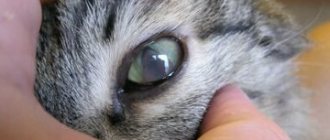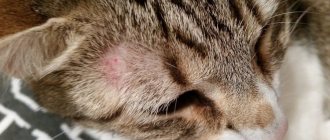general information
On that special day when a little fluffy ball appears in the house, the new owners worry little about how many years he will live.
Over time, the baby turns into a luxurious fluffy cat and takes pride of place in the family circle. As adulthood approaches, owners begin to have anxious thoughts: “How many years will the cat live?” On average, domestic cats live 10-16 years, but you need to understand that this figure depends on the breed, living conditions, nutrition, heredity and many other parameters.
Wild cats live less than domestic cats, about 5-6 years. The life expectancy of unadapted animals that were kicked out of the house is even shorter - 4 years. This is due to constant stress, the need to struggle for existence, poor quality food, severe weather conditions, illness, uncontrolled pregnancies and complications after them.
For your information: on average, cats live longer than cats, which is due to the wear and tear of the latter’s body after giving birth.
Pets that find themselves in a loving family can live up to 18-20 years. At the same time, the life expectancy of mustachioed striped animals has increased significantly in recent decades, thanks to the development of medicine.
Average life expectancy depending on breed
Some cats leave their owners at the age of 8 years, others can delight with their presence for more than 20 years.
With good care and the absence of congenital pathologies, cats of certain breeds can live this long:
| Abyssinian cat | 10-15 years |
| American Bobtail | 11-15 years |
| American Curl | 12-16 years old |
| American Shorthair | 15-20 years |
| American Wirehair | 7-12 years |
| Australian smoky cat | 14-19 years old |
| Balinese | 9-15 years |
| Burmese cat | 12-16 years old |
| Bengal cat | 10-16 years |
| Bombay cat | 12-16 years old |
| British Shorthair | 12-17 years old |
| Burmilla | 10-15 years |
| Havana | 10-15 years |
| Himalayan cat | 15-17 years old |
| Devon Rex | 9-15 years |
| European Shorthair | 15-22 years |
| Egyptian Mau | 12-15 years |
| California radiant | 9-16 years |
| Cymric | 8-14 years |
| Korat | 10-15 years |
| Cornish Rex | 11-15 years |
| Laperm | 10-15 years |
| Munchkin | 12-14 years old |
| Maine Coon | 9-15 years |
| Manx | 8-14 years |
| Norwegian forest | 12-18 years old |
| Oriental | 10-15 years |
| Ocicat | 10-15 years |
| Persian cat | 10-15 years |
| Pixie bob | 12-14 years old |
| Ragamuffin | 12-16 years old |
| Russian blue | 10-15 years |
| Ragdoll | 12-17 years old |
| Savannah | 17-20 years old |
| Selkirk Rex | 10-15 years |
| Siamese cat | 11-15 years |
| Siberian cat | 11-15 years |
| Singapore | 11-15 years |
| Snow-shoe | 12-15 years |
| Sokoke | 9-15 years |
| Somalia | 11-16 years old |
| Sphinx | 8-14 years |
| Thai cat | 11-15 years |
| Tonkinese cat | 10-16 years |
| Turkish Angora | 12-18 years old |
| Turkish van | 12-17 years old |
| Chartreuse | 11-15 years |
| Scottish lop-eared | 11-14 years old |
| Exotic | 8-15 years |
| Japanese Bobtail | 9-15 years |
Comparison of the ages of cats and humans
When thinking about the age of a pet, I want to recalculate it in human terms. A simplified formula tells us that one cat year is equal to seven of our years. However, in reality this relationship is nonlinear.
In the very first year of life, a tiny warm lump travels a long way, turning into a “15-year-old teenager.” In the second year, he lives for 9 years, that is, the cat becomes 24 years old. Each subsequent year adds 4 human years to him. The key point is considered to be 7 years of age, or 44 years in our opinion, when the cat shows the first signs of aging. If a pet lived for 16 years, then in human years it is 80 years.
Castration and sterilization
“Castration” - the term refers to a surgical intervention during which the gonads are removed; for females, the term “sterilization” is usually used, although both concepts are slightly different.
If an animal is castrated, it not only loses the ability to reproduce, but also the females stop having regular estruses. During sterilization, the female’s fallopian tubes are ligated or removed , which completely eliminates the possibility of pregnancy, however, hormones are still produced, so sexual instincts remain unchanged; it is preferable to do castration for females, since only in this way can the animal’s behavior be corrected.
How many years do cats of different breeds live?
This issue often causes controversy. Veterinarians believe that the lifespan of a domestic cat depends more on existing diseases and care, and not on its breed. Breeders do not agree with them, noticing that representatives of different breeds have different life expectancies.
First, let's compare purebred and simple cats. Genetically healthy, purebred parents give birth to purebred kittens. Naturally, their chances of living a long, happy life in a family are much greater than their wandering brothers.
Cats, which owe their birth to selective breeding, have relatively poor health. The structure of their body was artificially changed by geneticists. Other breeds are indigenous, they appeared naturally, adapting to environmental conditions. If we compare “designer” and “natural” purebred cats, the latter live longer. Selected breeds are prone to genetic diseases and require special care.
Let's look at the average life expectancy of popular breeds.
British
British cats have developed muscles, strong immunity and lead an active lifestyle. Representatives of this breed live 12-15 years, and some live up to 20, of course, with proper care. Genetic diseases are rarely observed in British cats. The risk of cancer is low.
British shorthair cat
Scottish fold cats
Teddy bear cubs are real long-livers! They have enviable immunity and can live up to 20 years. Examine your pet regularly, as its weak points are the ears and spine.
Scottish fold cat
Siamese
Siamese cats live 14-18 years. However, this breed has incredible endurance, and among them there are long-livers, living up to 30 years of age. The predisposition to a long life can be passed on from generation to generation, so before choosing a kitten, check with the breeder about its pedigree.
Siamese cat
Abyssinian cats
With proper care, Abyssins live about 15 years, some cats live up to 20. Representatives of this breed have a predisposition to diseases of the kidneys, retina, blood and teeth.
Abyssinian cat
Persians
Each variety of the Persian breed has its own life expectancy indicator. Cats with short noses live longer than their extreme and classic counterparts - 20 years versus 15. It is important to pay special attention to cats that have crossed the 10-year mark. At this time, the Persian's immunity weakens, and problems with joints, spine and kidneys may occur. You need to regularly visit the veterinarian, carefully pick up the cat in your arms, and take breaks from playing. Some Persians find it difficult to bend down; they should place the bowl on a slight elevation.
Persian cat
Russian blue cats
When properly kept at home, Russian Blue cats live an average of 15 years. It is possible to extend the life of cats as much as possible up to 18-19 years. Starting from the age of 8, the owner must take his pet to the veterinarian annually.
Russian blue cat
Bengals
Bengal cats live long lives due to their lack of cardiovascular disease. The average life expectancy is 15-16 years. Graceful Bengals are one of the strongest and hardiest breeds.
Bengal cat
Sphinxes
The average lifespan of a Sphynx is 10 years, but hairless cats can please their owners for 20 years. There is even a known case when a sphinx lived for 31 years. Pets of this breed can boast of excellent immunity even in advanced years.
Canadian Sphynx
Other breeds
The real long-livers, reaching 20 years, are the Thai breed, the American Shorthair and the Manx. The average life span of the Asian tabby and Egyptian Mau is one year less. Devon Rex, Japanese Bobtail and Tiffany reach adulthood. The Australian Smoky, Neva Masquerade and Maine Coon live a little less - 17 years. 15-16 years is the limit for the Arabian Mau, Asian Shorthair and Selkirk Rex. Exotic cats, Yorkie chocolate cats, and American bobtails live up to 14 or 13 years of age. The Bombay cat and Snowshoe can delight their owners for 12 years.
Life expectancy of cats by breed - table
The lifespan of cats and kittens directly depends not so much on the conditions of detention, but on the breed. Artificially bred hybrids live shorter lives than purebred animals or even those found on the street. Street cats often outlive their purebred peers due to genetically determined survival. Before choosing a beautiful cat based on its breed, it is worth finding out how long domestic cats of a particular breed live into old age.
| № | Breed | Average age, years |
| 1 | British cats | 12-15 |
| 2 | Persian cats | 15 |
| 3 | Siamese | 14-18 |
| 4 | Bald (sphinx, elf, pharaoh, Ukrainian Levkoy) | 10-12 |
| 5 | Scottish Fold | 15 |
| 6 | Burmese | 12-15 |
| 7 | Thai | 12-14 |
| 8 | Siberian | 13-17 |
| 9 | Maine Coons | 15-20 |
Balanced diet
How long a domestic cat will live depends greatly on its diet. A balanced diet is a reliable building material for a pet’s body. The main question that arises for a cat owner is: “What food is considered correct?”
Most veterinarians believe that it is better to feed your cat ready-made food that contains all the minerals, nutrients, and vitamins necessary for health. But some experts suggest that such foods increase the risk of developing urolithiasis and diabetes. due to the high salt and carbohydrate content. It is better to give preference to premium and super-premium food. Manufacturers of cheap food save on protein; such products contain no more than 10% meat, the rest is vegetable protein and chemical components.
What determines the lifespan of a cat?
For some owners, representatives of the cat family live a long time, while for others they often get sick and do not live to old age. Why is this happening? This depends on a number of factors. And it is very important to know about them to help furry beauties live longer.
How many years cats live depends on:
Genetics. An animal’s predisposition to various types of diseases depends on genetically stored information.
Habitats. Life expectancy depends largely on the environment in which the cat is located. Those individuals that live the longest are those that do not go outside at all and are surrounded by the care and love of their owner. The same cannot be said about those who live on the street.
Outdoor cats are constantly exposed to various deadly dangers. For example, an animal can easily become infected, be poisoned by spoiled food, fall under the wheels of a vehicle, be injured as a result of a fall, or a dog attack. Some become victims of inadequate adults and evil children. Therefore, the life expectancy of cats at home is much longer than that of street cats.
Some owners let their pets go outside for walks. It’s worth noting that indoor cats that are allowed outside are at even greater risk than those that constantly live in the yard. The street cat is used to constantly fighting for life. She is always ready to defend herself. And thanks to the instant reaction, he often saves his life.
When a homely beauty goes out for a walk, she feels more relaxed and does not always understand the risks that threaten her. As a result, she can easily become a victim of aggressive and dangerous street life. Therefore, the life expectancy of a cat that does not leave the apartment is longer. The animal is protected from various external dangers by the walls of the house, there is always fresh food and clean water, the pet does not freeze in winter, and does not get wet in the rain in the fall.
Nutritional features. How long domestic cats live depends greatly on their diet. A balanced diet can prolong the life of your pet. But what kind of nutrition can be considered correct? Some veterinarians believe that it is better to feed ready-made food that contains all the necessary and healthy minerals, nutrients, and vitamins.
But there are also those experts who are of the opinion that ready-made food is harmful to animals and increases the risk of developing urolithiasis and diabetes. And the reason for this is the high salt and carbohydrate content. Therefore, all food must be exclusively premium. Cheap food contains no more than 10% meat. They mainly contain vegetable protein and various chemical components that destroy the health of your pet.
Sterilization. How long cats live on average also depends on sterilization. Veterinarians claim that the operation prolongs the animal’s life. Sterilized cats have no risk of developing reproductive diseases. Many people believe that cats that give birth greatly undermine their health. And therefore they live less. True, there are also opponents of sterilization. They think that after the operation the animal becomes inactive and apathetic. And this leads to obesity and the development of diabetes. Read about the pros and cons of sterilization here.
Presence of chronic diseases. How long cats live at home depends on the presence or absence of diseases. Naturally, only healthy animals live long. If there is a chronic disease, the pet is unlikely to become a long-liver. So, a cat with diabetes can live for a maximum of 4 years. And only if you take care of it properly. Urolithiasis also shortens life expectancy. A pet with this diagnosis can live 5 years, no more.
Stress. Animals that live in peace and love, in families with an optimal psychological climate, can become long-livers. A constant nervous environment, when the owners systematically scold and physically punish, greatly affects how long the cat will live.
Thus, how long domestic cats live on average depends on a number of factors. Only an animal that eats well and properly, lives in love, and is surrounded by care can become a long-liver.
Sterilization
Sterilized cats live several years longer than their furry friends - 15-20 years. But the situation is not as clear-cut as it might seem at first glance: according to some doctors, sterilization can lead to apathy and inactivity of the animal, which will further affect the development of diabetes, obesity and ultimately lead to a shortened life.
By 8 months, cats become sexually mature and can give birth several times a year, but pregnancy is accompanied by hormonal changes. Hormone fluctuations are a great stress for the cat’s body and negatively affect life expectancy. Moreover, pets who do not give birth and are not sterilized are at an even higher risk of developing cancer.
Without gonads, a cat does not need contact with the opposite sex, which means it will not contract a dangerous disease from a male.
How long do cats live at home?
The lifespan of cats in an apartment or house, as stated above, is about 15-18 years. To achieve this indicator, you need to provide proper nutrition that is suitable for the breed, and regular visits to the veterinarian. Separately, castration or sterilization of your pet is recommended. All these factors should prolong the cat’s life as much as possible and make it comfortable around humans.
Neutered cats
Castration of a cat reduces hormonal levels, makes the animal more docile, and relieves the owner of marks in the room and sexual activity. The average lifespan of castrated cats at home is 5 years longer than normal. It is ideal to castrate at an early age, before hormonal changes in the body occur. It is important to monitor the health of such a cat, because they are very susceptible to obesity if you do not provoke them to activity (the lack of hormones makes pets lethargic and lazy).
Neutered cats
Neutering cats also prolongs life by about a quarter. A healthy animal can give birth up to 4 times a year, which is a serious physical and hormonal stress for the body. Experienced veterinarians call the optimal period when it is best to carry out sterilization from eight months to one and a half years. Just like cats, sterilized cats need to be closely monitored, the right food and vitamins should be selected, and they should be encouraged to be active in every possible way.
Long-lived cats
The Guinness Book of Records records a long-lived cat from Texas - Cream Puff. She died in 1967 and died in 2005. Cream Puff lived 38 years and 3 days. Its owner was an American from Texas.
She has a competitor from the UK. The cat Lucy is already 43 years old. By human standards - 188 years! She is cheerful, cheerful and energetic, but has almost lost her hearing.
The beautiful Lady Catalina lives in Australia. This Burmese cat is 37 years old. Despite her advanced age, she is active and healthy.
How long can cats live without food?
No living creature can live without food. The quality and regularity of food greatly influence how many years domestic cats live. A healthy individual can eat up to six times a day. There are times when an animal itself refuses to eat: when sick, during estrus, in a bad mood, in the early stages of pregnancy, during stress, and for a number of other reasons. If a cat has free access to water, she can go about five days without eating. With a longer absence of food, about two weeks, cats may experience irreversible consequences for the body.
Tips for owners
- Provide your cat with good quality nutrition, access to clean water and a special diet if necessary. Monitor portion sizes; it is especially important not to overfeed your pet after spaying or neutering. It is strictly forbidden to feed cats pork (high fat content), bones (damage to the digestive tract), legumes (bloating), and dog food.
- Don't skip regular veterinary checkups and vaccinations. Treat your cat with attention and love, these fluffy beauties know how to mask their pain, so if there is the slightest change in your pet’s behavior or condition, it is better to consult a specialist.
- If you do not plan to breed cats, spay or neuter the animal. This will help him stay healthy for many years to come.
- An active lifestyle with regular physical activity is the best friend of long-lived animals.
- Strictly observe hygiene standards, take care of the animal’s teeth, and do not neglect prevention of worms and fleas.
And remember, a cat does not have 9 lives, as the cliché tells us, but only one, which she will spend next to you. May every day be filled with joy and happy moments for both of you! Take care of the fluffy beauty - and she will repay you in full with her tenderness and love.
How to extend the life of a pet
Proper care, coupled with due attention from the owner towards the pet, will help increase the cat's life expectancy.
Owner's attention
Almost all pets become strongly attached to their owners. Cats are considered the most pampered pets, who prefer to receive signs of attention rather than bestow them on their neighbors. Owners should understand that a lack of affection can often ruin the purr’s psyche.
Common mistakes in keeping cats
Everyone wants their pussy to live with them for a long time, to delight their household with its presence, playfulness, and purring. But some pets get sick and die prematurely due to various mistakes of their owners.
Feeding on demand
Adults should be given cat food no more than 2 times a day. Too frequent feeding often provokes the development of obesity, which has a detrimental effect on the functioning of the heart. Veterinarians usually prescribe a special diet for an overfed cat that can normalize the purring body weight.
Walking without supervision
It is not permissible to let a domestic cat go outside without being accompanied by its owner and a leash. Otherwise, he will rummage through garbage cans and may eat the spoiled food there and become poisoned.
Also, the pet is not immune from fights with more aggressive relatives, and fights are often fraught with serious injuries.
Loneliness
There are many cases where cats greatly missed their owner, who had to leave the pet for a long time for one reason or another. These animals did not live long.
Don't leave your purrs! Don't hurt their psyche! This is especially true for owners of sterilized cats, as well as neutered cats.
Frequent bathing
Bathing is almost always stressful for purrs. For this reason, water procedures should be carried out only when necessary.
Long-haired pets, as well as hairless pussies, should be washed more often than usual. A dirty animal will have to be given a good bath. And naturally, the fluffy mustache will need to be “beautified” before the exhibition. In general, it is enough to bathe an ordinary pussy once every 6 months.
Canine behavior requirement
Owners should be aware that it is unacceptable to treat a cat like a dog. Even if she lives in the house together with a dog, and these two pets are friends with each other, you need to understand the difference in the psychology of these animals.
A dog is distinguished above all by devotion. She values rigor more than tenderness. A cat, on the contrary, is characterized by a love of freedom. She would not be able to sit on a chain all day, like a dog, and also sleep in a cold booth - this would be a terrible nervous shock for her.
The purr also needs more tenderness. For this reason, it is unacceptable to raise your voice at a cat, in order to avoid the development of stress in the animal.
How long can a cat live without water?
Lack of water is more dangerous for cats' bodies than lack of food. The volume of fluid consumed in cats is influenced by the breed, diet, and time of year. So the British are a special species that gets by with virtually no water. If a cat eats exclusively or predominantly dry food, he needs a large amount of liquid. In the summer, even one day without moisture can seriously affect the overall well-being of the animal. During the cold season, a cat can go without water for about three days. As you can see, the lack of water can greatly affect the life expectancy of cats.











